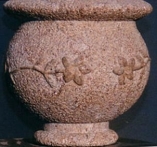The Euganean hills as well as for the production of wine are also famous for the extraction of trachyte. Its was used in the Paleovenetian period for the construction of building works and in Roman times for building-canal works. In the 1950s it was used to build the banks of the Po River after it overflowed especially in the province of Rovigo. This caused financial abuse as trachyte was paid for without control over the quantities actually used. It is a hard, magmatic, siliceous stone with various colors. Brown with darker veins, gray-blue, gray, brown-blue, yellow-brown. Many palaces, squares, works of art from Padua, Venice, Vicenza, Treviso and not only are worked with this stone. It is a rock that lends itself to any type of work, from work in facing or facciavista and bush-hammered to those polished and polished. Often it is placed next to wood due to its similarity. In ancient times it was said that trachyte is a living stone because cutting a boulder just removed from the wall inside it can be seen a trickle of water. For centuries these quarries have donated riches to our Venetian works of art by offering jobs to native stonemasons who extracted and worked the trachyte of the Euganean Hills. Now they are bound by the Euganean Park body which introduced fauna that originally did not exist impoverishing ancient activities that can no longer operate despite possible advanced ecological landscape redevelopment resources.



